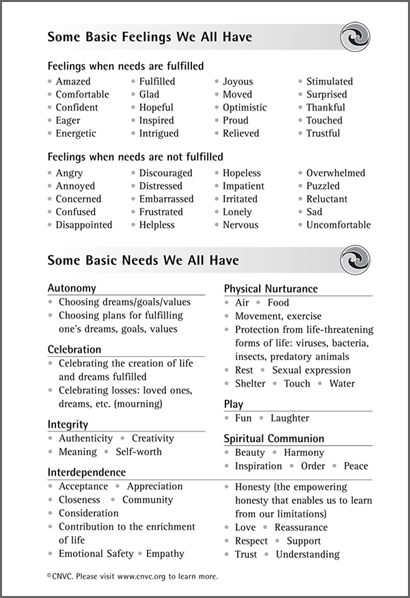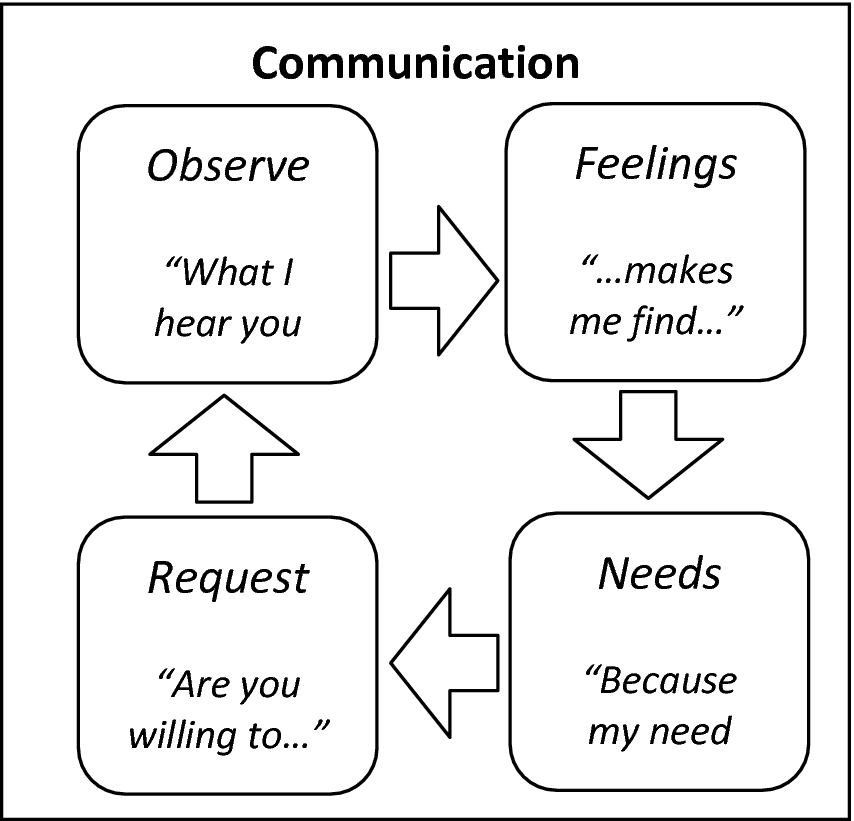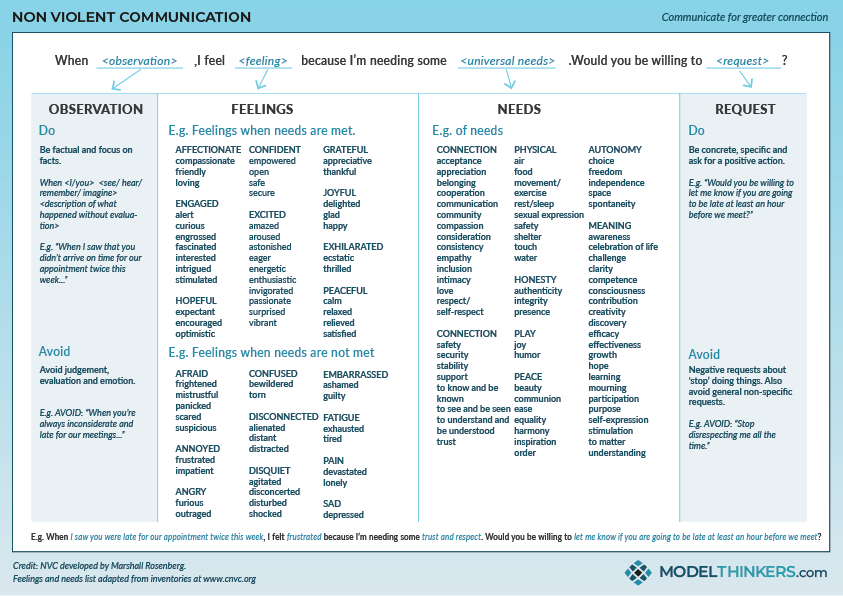Ever heard of non-violent communication? An effective communication manager to express our feelings. Why our society needs more strategies of effective communication to develop empathy and compassion.

Poor communication can be the root of too many other issues in the way we handle people and show up for ourselves. Communication skills are fundamental to gaining a better understanding and perspective towards how others feel and think, it is vital when dealing with conflict situations too.
Non-violent communication can help us in all of our relationships (intimate relationships as well as friendships) as well as business or leadership positions (eg. in a job interview) and even dealing with unresolved conflict in family settings.
Learning and practicing to communicate properly, in an empathetic are life-changing tools as it smooths out the communication process through conflict resolution and cultivates healthy relationships.
Note: When we talk about communicating this includes non-verbal communication too – our facial expressions and body language can convey entire stories, feelings and thoughts sometimes more than we are consciously aware of or express through words.
Nonviolent communication a language of life
The Nonviolent communication theory (NVC) is a way of interacting that focuses on compassionate communication and active listening rather than aggressive argumentation or emotionally charged, reactive responses.
Nonviolent Communication is a style of communication that has been used successfully for centuries in various cultures, such as Japan, China, India, and Nepal as well as in different situations.
Communication styles such as Nonviolent Communication is a system for resolving conflicts between two parties using empathy, acceptance, and tolerance.
Nonviolent Communication is based on the premise that no one has the right to judge another person’s behavior as they try to understand the underlying cause of their reactions. The goal of NVC is to help individuals communicate effectively with themselves and others.
Famous examples of the power of NVC include Martin Luther King Jr., Nelson Mandela, and Mother Teresa.
Marshall Rosenberg nonviolent communication
Who is Marshall B. Rosenberg?
The creator of NVC was Marshall B. Rosenberg, an American psychologist, meditation practitioner, author, and teacher. He developed nonviolent communication, a method for supporting partnerships and resolving conflicts between people, in relationships, and in society. He worked worldwide as an international peacemaker and founded the Center for Nonviolent Communications in 1984.
The Pillars of Nonviolent Communication (NVC) – Effective communication skills
There are 6 elements that are fundamental to successful nonviolent communication. These elements form the foundation for effective communication.
Observations
Observation refers to being aware of how we are feeling and how our thoughts and feelings are conveyed through our speech. We’re making observations about our surroundings, and we’re trying to understand how the other person is feeling and why. We need to make sure that the other person knows what we’re thinking, and maybe what we want from them.
The key to making an observation is to separate our own judgments, evaluations or interpretations from our description of what happened. For example, if we say: “You’re rude,” the other person may disagree, while if we say: “When I saw you walk in and I didn’t hear you say hello to me,” the other person is more likely to recognize the moment as rude that is described.
When you listen to someone who uses observation language, you notice things about them that you might not have noticed before. You may think about how your friend feels based on these observations. This can help with helping people understand each other better.
Learning to become conscious of what we feel about another person creates the possibility of having some kind of genuine interaction with them. Our self-awareness leads to empathy. This means being aware of how we feel about someone else, which allows us to be more empathetic towards them. Empathy allows people to work together effectively. It also gives us insight into our personality traits and behaviors.
Feelings
When it comes to feelings things can get complicated which I am sure everybody can relate to…
So here are a few simpler steps to navigate the world of communicating feelings and emotions effectively.
1. Identify – Feelings represent our emotional experience; our inner world – what are you feeling towards this situation and why do you feel the need to share it?
2. Express – Expressing feelings allows us to make sense of them because we share them with others.
3. Take Responsibility – Identifying and expressing feelings help others hear what is important to us, instead of interpreting their behavior. Take responsibility for your feelings to open the space up for others to do the same. We want to avoid playing the blame game for certain feelings that we are experiencing – what you are feeling is about you and putting blame on others will create more tension or conflict.
This is especially difficult when the other person has done us wrong in some way. Instead of blaming the person stay curious on why it has effected you the way it has and express this openly to the other person – get their perspective. You can make it clear that what they have done has upset you ut you do not need to blame them. Blame only leads to emotional outbreaks and that is not helpful when trying to resolve a conflict.
This might sound like: “The way you have treated the situation has made me feel upset and hurt and I would like to try and understand why you reacted the way you did so that we can find some closure.”
4. Respond not react – By responding, not reacting, we continue the process that takes responsibility for our own experience, which enables others to meet our needs with less likelihood of hearing criticisms or blame of themselves.
Needs
Identifying needs through nonviolent communication (NVC) and then expressing them verbally, helps us connect with others around us and connect with ourselves.
It helps us understand each other better and develop better relationships which can create a positive impact on other aspects of our lives.
Expressing our needs enables us to live more authentically and connect deeply with each other as it makes us feel empowered, understood, and liberated.
Feelings arise whenever we don’t feel cared about or we feel our needs aren’t being met.
Connecting with our needs and then expressing them will minimize the chances of something triggering us because we feel there is a safe space that has been created where our needs and our authentic selves are held.
We feel seen.
This might sound something like: “I need to let go of overthinking the situation that has unfolded and I would like to move past it through expressing how I feel. What do you feel you need?”

Requests not demands
Demanding holds very different energy to requesting…
From demands to requests, we become less controlling and more compassionate. We begin to see our own needs as separate from those of others, which allows us to treat others as separate individuals who may hold different priorities. We can no longer assume that others know what we want and how they are supposed to respond. We must learn to say what we need* and ask for it.
* Notice that I say needing over wanting. Wanting is more of a demand as it can come from the ego while needing is more of a request as it comes from an innate experience.
We begin to develop a greater sense of self-compassion, recognizing that although we may think we are acting in our best interest, we may be hurting ourselves or someone else by insisting on certain outcomes.
From a pragmatic perspective, if we make requests, we are less likely to end up in conflict with others. If we make demands, we are more likely, over time, to get into conflict.
Conflict arises when we are unable to resolve differences in our perceptions of reality. One party perceives something differently than the other, and therefore cannot see things from the same perspective. Because we all perceive reality from different vantage points, we are prone to interpreting reality in the way that feels right to us. If we are not open to hearing another point of view, we risk ending up in conflict with the other instead of working together. Demanding only recognizes your point of view, which is why it comes across as confronting and selfish, where requesting recognizes the other person’s perspective as well as your own.
Requests build trust and goodwill. If we have a good relationship, we already trust one another. Requesting means committing to trusting the other even when they don’t give us exactly what we ask for. It also opens us up to receiving support when we don’t receive everything we ask for immediately. When asked, “What do you need?” Requesting is knowing that you might not get instant gratification where demanding is “I want what I want and I want it now”.
Conflict can often either be a result or lead to vulnerability. If we are used to making demands, we are likely to keep our vulnerability hidden or blame someone else for our inability to meet our needs. Making requests requires us to reveal our vulnerabilities to others. By asking for what we need, we put ourselves out there and invite the other to respond by sharing their feelings, thoughts, needs, hopes, fears, etc.
A request allows room to grow. When asked, “How can I help you?”.
A request is a two-sided give and take while a demand is a one-sided take.

Empathy
Empathy is an entire article on its own but it has to be mentioned here too…
Nonviolent Communication enables us to connect deeply and empathically with others as it avoids blame or judgment.
If someone creates an empathetic space we feel comfortable sharing our needs without feeling judged because we know it will be met with understanding and respect.
It creates connection, not fear, through positive feedback.
The power of empathy lies in its ability to create change in the relationship as it forms a bridge of emotional understanding between people.
Self-Empathy
As we know most things start with ourselves first. We cannot show true empathy to others if we are not showing to ourselves.
Communicating empathy starts with self-empathy, this includes:
- Nurturing and developing your self-compassion.
- Opening channels towards being comfortable with direct communication as we have built an awareness of what thoughts we would like to put forward and portray.
- Gaining insight into yourself and others through self-awareness.
- Developing your presence.
- Awareness about our needs and feelings.
- Intentionality and commitment to listen compassionately to ourselves and others.
- Emotional regulation skills.
- Building resilience.
- Transformation of the mind.
- Tapping into our intuitive mind and what feels right.

Conclusion
Once again as with anything relating to mindful living, it comes down to awareness – awareness of self which then translates into awareness of others. The role of mindfulness is huge within communicating and the effects of mindfulness is vast.
Practicing awareness towards our feelings, emotions, thoughts, and intentions allows us to feel safe within ourselves to express this which then creates a safe space for others to do the same.
Practicing mindful communication such as non-violent communication in all areas of life can be so beneficial to how you show up in this world and simultaneously how you learn to understand the world and the people in it better.
It creates a positive impact for all – the more people learn to communicate without reactivity the more empathy society will show towards each other, the more positive relationship forms and the less conflict will arise.
Nonviolent communication builds a happier, more connected, and consciously aware society.
It is a skill that is vital towards our own growth, as well as society’s, as it has a snowball effect by changing the way we approach most things – with more compassion and less ego.


